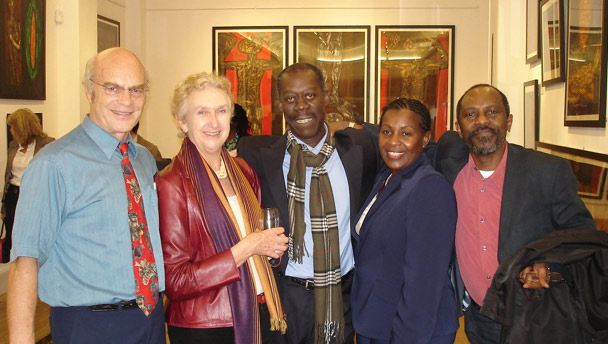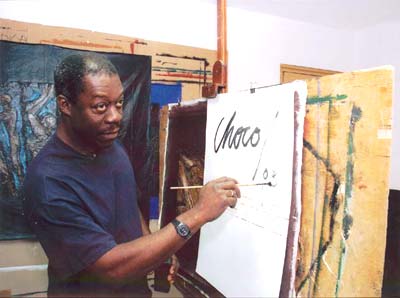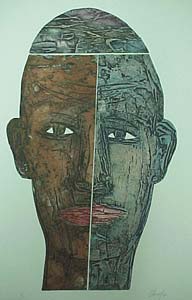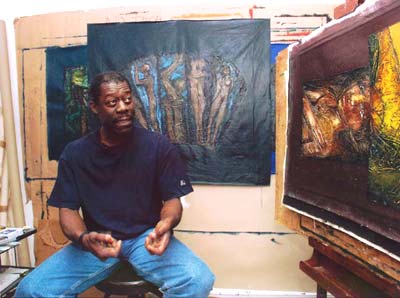

 |
AfroCubaWeb
|
 |
Eduardo Roca Salazar (Choco)
|
|
The Artist —Eduardo Roca (Choco) Salazar from MSU School of Global Journalism |
| Latin Art Space Cuban, Mexican, and African Art and Culture Master of Collagraphy - Eduardo Roca Salazar "Choco" March 15, 2012 EXHIBITION: Eduardo Roca Salazar (Choco) Retazos del Sol - Traces of the Sun DATES: April 26 – August 31, 2012 OPENING: Artist Reception and Talk with Choco from Havana, May 3, 6:30-8:30pm LOCATION: Multicultural Arts Center, 41 2nd St., Cambridge CONTACT: Astrid Martinez-Jones, latinartspace_AT_gmail.com Renowned Afro-Cuban artist, Eduardo Roca Salazar (Choco) will be in Cambridge, MA from Havana for the opening of his most recent art exhibition, Retazos del Sol (Traces of the Sun). Choco is internationally recognized for his collagraphs, a printmaking technique in which the image is composed from a variety of textured materials placed on a plate, then inked and pressed. These materials, often discarded remnants, are recycled by Choco and turned into vibrant images that beckon to be touched. As is evident in Choco’s work, collagraphs provide opportunity for a tremendous scope of innovation and experiment. On view at the Multicultural Arts Center in East Cambridge and sponsored by Latin Art Space, Retazos del Sol is a series of works representative of contemporary Cuban life and culture. Choco’s work reflects the magical world of Afro-Cuban religions, as well as the ethnic mix of people, and the racial and economic challenges of daily Cuban life. Choco’s collagraphs are boldly colorful and his technique gives the images a 3-dimensional and stunning textured feel, as if they were in motion. This movement is sustained in Choco’s interpretation of the figures themselves, where bodies are twisting and reaching, swaying or working, and often entranced in a deep gaze. His figures deliberately reflect the racial and cultural mix of Cubans, with an African mouth, oriental eyes and various shades of skin color, portraying a universal individual with whom many will identify. The sharp contrast of colors responds to his particular symbolism and to a very personal lyricism, which establishes an emotional connection with the viewer. He displays a passion for diversity, and admiration for societies with a rich mixture of ethnic, racial, and cultural backgrounds, such as those found in Cuba, the United States, and Brazil. Choco was born in Santiago de Cuba in 1949 and is a graduate of the Escuela Nacional de Arte (National Art School) in Havana. Along with Nelson Dominguez, he was one of the first Cuban artists -after the 1959 Cuban revolution- invited to the United States to exhibit his work in 1980. There have been two crucial moments in Choco´s career. The first, when he was recognized as one of the leading figures of the rural movement in painting which was significant in shaping the 70’s generation of Cuban artists. The second was his exploration of collagraphy in the 80s and early 90s, an achievement that has awarded him the distinction, master of collagraphy. Choco has had numerous solo and group shows in Cuba, Angola, Sweden, the United States, Mexico, Spain, Columbia, Puerto Rico, and Tokyo, receiving many accolades and awards. A most important honor for him was winning the Great Prize in the Triennial of Kochi, Japan. Choco’s works can be found in many private and public collections, including: Museo de Bellas Artes, Havana; African Museum of Art, Chicago; Miro Foundation, Spain; Ludwig Foundation, Germany; Kochi Museum, Japan; El Museo de la Estampa, Mexico; and Casa Lamm, Mexico, amongst others.
In his Taller del Sol (Workshop of the Sun) in Old Havana, art collectors, museum curators, and gallery owners come from all over the world to experience the magic of his artwork. Choco’s visit to the Greater Boston area will afford viewers a rare opportunity to engage in informative conversations with the artist about his work, and life as an artist in Cuba.
Master of Collagraphy - Eduardo Roca Salazar "Choco" 1/31/2012 Latin Art Space: At the Multicultural Arts Center in Cambridge, MA - Opening Reception Thursday, May 3, 2012 - On Exhibit May 3 - August 31, 2012 |
|
Eleggua, 2004
Choco (left) with author Pedro Perez
Sarduy (right), May |
1976 Galería Oriente, Santiago de Cuba, Cuba 1977 "Hombres de Mocha", Galería Habana, Habana, Cuba 1978 Galería Central de la Isla de la Juventud, Cuba 1980 Galería de Arte de Bayamo, Cuba Galería Barrio Viejo. Estocolmo, Suecia 1981 Galería Misión. San Francisco, USA 1982 Galería de Arte del Grabado "Francisco Javier Báez" ,Plaza de la Catedral, Habana, Cuba 1984 Casa de la Cultura Regional del Municipio Centro Habana. Habana, Cuba Casa de la Cultura Pirámides. México DF, México 1987 "Cosas Sueltas", Galería Plaza Vieja, Fondo Cubano de Bienes Culturales. Habana, Cuba 1989 Sala Provincial del Palacio de Málaga, España 1992 "Una Transparencia Cubana", Centro de Prensa Internacional, Habana, Cuba "Una Transparencia Cubana". Museo de la Estampa, México Casa de la Cultura Reyes Héroles, México Galería Pedro Domec. México 1993 Galería "Alonso". Bogotá, Colombia "Para el Amigo Sincero". Foro Cultural de Coyoacán 1994 Talleres y Fundación "Joan Miró". España 1995 Galería Atlántica. La Coruña. España Galería Medioevo, Fuenterrabia. San Sebastián, España 1996 Museo de Bellas Artes. Tokio, Japón "En la Zona del Crepúsculo". Castillo Sotomayor. Galicia, España "Grabados". Galería Domingo Ravenet. Habana, Cuba 1997 Museo Yokohama. Tokio, Japón 1998 "Grabados". La Casona, Fondo Cubano de Bienes Culturales. Habana, Cuba. "De Muros y Transparencias". Centro Cultural Pablo de la Torriente. Habana, Cuba 1999 Exposición de Grabados. Kochi, Japón "Sorteando Caminos". Galería Acacia. Habana, Cuba 2000 Galería PromoArte. Tokio, Japón Galería París. Yokohama. Japón Galería Benito Ortiz. Trinidad, Cuba. 2001 "Choco...late". Memorial "José Martí". Habana, Cuba Galería Somart. "Estilos cubanos". San Francisco, USA Galería Somart. "Estilos cubanos". Washington D.C., USA Museo de las Américas, "Al Filo del Milenio". San Juan, Puerto Rico llucmajor, "Pinturas y Grabados". Mallorca, España 2002 Galería PromoArte. "Los Misterios del Azul". Tokio, Japón Museo Erasto Cortes. "Cubaenlagráfica". Puebla, México 2003 Centro Cultural Casa Lamm "El Soplo de la Vida". México |
Master of Collagraphy - Eduardo Roca Salazar "Choco" 1/31/2012 Latin Art Space: At the Multicultural Arts Center in Cambridge, MA - Opening Reception Thursday, May 3, 2012 - On Exhibit May 3 - August 31, 2012
Gallery opening in London, 10/11/2007
| Exhibition Start Date | Thursday 11th October 2007 |
| Exhibition End Date | Friday 9th November 2007 |
|
There have been two crucial moments in Choco´s career. The first, when he was recognised as one of the leading figures of the ´epic-rural´ movement in painting which was so important in shaping the ¨70´s generation¨ of Cuban artists. The second moment was his exploration of ´collography´ in the 80s and early 90s, an achievement only matched in Cuba by the well-known engraver,
Belkis Ayón. |
|
BY ESTRELLA DIAZ — Special for Granma International IT’S not that the British have stopped drinking tea. No. It’s that during this October, at the Chambers Gallery in London, they can admire the one-man show of Chocolate, alias Eduardo Roca Salazar, one of the most outstanding and significant figures in Cuban contemporary visual arts.
This exhibition by Choco —his first one-man show in that country— is something of a “preview,” because in September 2008, a series of Cuban cultural events will take place in this capital, including music, film, ballet and visual arts exhibitions. Michael Chambers, owner of the above-mentioned gallery, recently traveled to Havana and visited the Taller del Sol workshop, named after the street where it is located, and where Choco currently works. There, acting as curator, he chose about 50 works of art, most of which are larger than four square meters, and which are oil on cloth, colagraphy and mixed media. According to the artist, he is satisfied with his selection and believes that it is a “very interesting exhibition for British eyes.” All of the pieces were made during the last three years, after his one-man show in the National Museum of Fine Arts (2004), titled Abanico de posibilidades (Range of Possibilities), an important moment in his creative activities, a profound look back, given the degree of maturity and the solidness of his creations. From then to date, Choco’s body of work has expanded and experienced growth; that is perhaps due to the fact that his workshop – thanks to efforts by the City Historian’s Office – has increased not just physically, but also “in themes.” “I believe that I am at an excellent moment to continue creating the work that my people and my country deserve,” Choco commented. He added, “I don’t know if in the immediate future I will experience a change of theme: those are things that one never knows; they are aspects that you cannot predict, but the result comes out of a profound analysis of who we are and how far we have come as a people, as a nation.” Throughout this year, Choco, a tireless worker and a laboriously systematic artist, has participated in several collective exhibitions, and one of them, because of its humane significance, holds special importance: “The one dedicated to the Cuban five, who are unjustly imprisoned in the United States.” He has also illustrated several books and a collection of African short stories. “That work expands your thinking and enriches your work,” he affirmed, noting that before the year is over, he plans to travel to his native province of Santiago de Cuba in the east to participate in an exhibition of religious-themed work. “I
think the mystical subject is important, because it nourishes us as
human beings and makes us better,” he concluded. |

Vernissage de "Choco" in London -Private View October 11, 2007
From Left: Michael Chambers (owner of The Chambers Gallery); Jean
Stubbs; "Choco" and wife Gloria Garcia, and Pedro Perez Sarduy
| “Me estoy preparando con todos los hierros, ya verán” es la frase que se le escapa a Eduardo Roca Salazar, Choco, segundos después de revelar, en exclusiva para La Jiribilla, que en mayo del venidero año realizará su primera exposición personal en el Museo Nacional de Bellas Artes. Estrella Díaz| La Habana Fotos: Cortesía del artista y del Centro Pablo de la Torriente Brau  Eduardo Roca Salazar, Choco, quien por la calidad de su obra, ha sido considerado por la crítica especializada un “maestro” del grabado contemporáneo cubano es, también, un sólido pintor que tiene entre sus temas favoritos La Habana y sus gentes. Eduardo Roca Salazar, Choco, quien por la calidad de su obra, ha sido considerado por la crítica especializada un “maestro” del grabado contemporáneo cubano es, también, un sólido pintor que tiene entre sus temas favoritos La Habana y sus gentes. “Me estoy preparando con todos los hierros, ya verán” es la frase que se le escapa, segundos después de revelar, en exclusiva para La Jiribilla, que en mayo del venidero año realizará su primera exposición personal en el Museo Nacional de Bellas Artes. Recientemente este creador —que insistentemente utiliza como medio de expresión la colagrafía, una de las tantas técnicas del grabado—, regresó de México, a donde viajó con una exposición titulada El soplo de la vida. —A México voy anualmente porque de ahí sigo hacia Japón donde en los últimos diez años mi obra ha tenido aceptación. Una década atrás trabajé estrechamente con varias galerías como La Praxis, la Casa de Cultura Reyes Seroles, Museo de Querétaro, en el Museo de la Estampa en el DF. En los noventa la situación en ese país se puso un poco complicada y decidí retirarme. Luego me di cuenta que México era una plaza interesante —entre otras razones— porque posee una artesanía muy fuerte, con una tradición humana y cultural sólida. Me dije: tengo que volver y lo hice el año pasado con una muestra en el Museo Erasto Cortéz, en Puebla que es una ciudad preciosa, maravillosa, en la que se respira cultura a través de sus iglesias y sus universidades. Establecí un contacto con la Casa Lamm, gentes maravillosas, lugar impresionante; pienso que es un sitio en el que — aunque elitista— se puede incrementar la posibilidad de realizar muestras y otras actividades porque su entorno engendra vida cultural. Decidimos entre Claudia Gómez y Germaine Gómez, ambas de la directiva de esa Casa Lamm, montar mi exposición para tratar de entrar nuevamente en ese mercado. —¿Por qué El Soplo de la vida? —Mi familia y a la gente que me rodea en el Taller Experimental de la Gráfica de la Plaza de la Catedral, se impresionaron mucho con una obra que hice en los años noventas que se llamó, precisamente, El Soplo de la vida.  En ella hay diferentes momentos de índole político, social y económico; es una pieza muy impactante. Mi ministro (Abel Prieto, titular cubano de cultura) me comentó que era una obra significativa entre las muchas que he realizado. Esa pieza estaba incluida en la muestra que llevé a México y por eso decidí ponerle este título.
En ella hay diferentes momentos de índole político, social y económico; es una pieza muy impactante. Mi ministro (Abel Prieto, titular cubano de cultura) me comentó que era una obra significativa entre las muchas que he realizado. Esa pieza estaba incluida en la muestra que llevé a México y por eso decidí ponerle este título. —¿Cuántas obras integraron la expo? —Dieciocho piezas de diferentes tamaños, incluido El Soplo de la vida —que tiene tres metros— y alrededor de doce matrices donde también estaba incluida la de El Soplo… Esto le dio un acento muy interesante a la exposición porque el espectador podía ver el ejemplar junto a la matriz y hacer un intercambio de lenguajes, contextos y lecturas. Como algo didáctico me parece importante. —Esta no es la primera vez que expones obra contra matriz; recuerdo tu exposición personal en la Sala Transitoria del Memorial José Martí, cuya curaduría estuvo a cargo de Roberto Chile. ¿Por qué retomas esta idea? —El espectador es siempre muy disímil e invariablemente quiere saber. El hecho de mostrar la matriz causa un interés mayor a la hora de apreciar porque es como si estuviera viendo un espejo. Ello da la posibilidad de casi volar a la hora de interpretar una obra ya que estás mirando parte importante de su proceso, de su génesis. Cuando hago una muestra me encanta ofrecer estas dos partes porque veo el asombro. Si yo me sorprendo, ¡imagínate el efecto de causa en otros!. Constato que las personas tienen un nivel de interpretación con una fuerza espiritual impresionante. Vacilo —si se quiere— cómo la gente se para a mirar, a descubrir, a leer todo lo que está pasando a su alrededor en relación con la obra impresa y con la matriz.  —Las artes plásticas tienen mucho de técnica, pero también de magia. El hecho de desnudarte como creador, de enseñar la matriz y luego la obra concluida ¿no matará un poco, no dará muchos elementos al espectador, no será descubrirte demasiado?
—Las artes plásticas tienen mucho de técnica, pero también de magia. El hecho de desnudarte como creador, de enseñar la matriz y luego la obra concluida ¿no matará un poco, no dará muchos elementos al espectador, no será descubrirte demasiado?—Otras personas piensan lo mismo. Cuando alguien me pide orientación —sobre todo en lo relacionado con la colagrafía— le digo hasta del mal que va a morir; no me preocupa; esos son mis secretos. Les digo, pero no les hago. Si logran un resultado, tal vez, me den un valor que no tengo. —¿Planes para lo que resta del 2003? —Bastantes. Este año estoy interesado en hacer un recorrido por varias provincias cubanas. Ya estuve por Colón y Sancti Spíritus, después viajaré a Matanzas y Holguín, luego tengo algunos compromisos en el extranjero. En el mes de julio iremos a las ciudades canadienses de Toronto y Montreal, después a Francia, Londres, Italia y concluimos en Grecia. Por primera vez tres artistas —los maestros Manuel Mendive, Roberto Diago y yo— agrupados en torno a un proyecto que auspician las Fundaciones Havana Club y Pernod Ricard Internacional, intentaremos mostrar cómo somos los cubanos a partir de nuestras propias vivencias y obras. La elección es interesante porque —además de querernos mucho— poseemos visiones muy diferentes. Hay esculturas realizadas por Mendive, óleos sobre lienzo hechos por Diago, grabados míos y varias instalaciones de los tres. Se va a aumentar el tamaño y la cantidad de piezas de cada uno; será una muestra grandísima con alrededor de treinta y cinco obras de cada uno. Si aplicamos la matemática elemental, suman más de 100. No queremos impresionar al mundo, vamos a impresionarlo. También, como grupo, estaremos en la Bienal de Artes Plásticas de La Habana y trabajaremos en un solar de La Habana Vieja con público, en vivo. Aunque aún no tenemos todos los detalles queremos interactuar con el espectador y eso será parte de la Bienal. Estoy motivado con ese proyecto”. —Esas giras nacionales que mencionas ¿cómo están organizadas? —A partir de exposiciones personales que incluyen algunos conversatorios, encuentros y clases magistrales. Visitaremos escuelas especializadas, grupos de artistas, nos reuniremos con miembros de la Unión de Escritores y Artistas de Cuba, UNEAC, y de la Asociación Hermanos Saíz. Las gentes en las provincias están con muchos deseos, con hambre intelectual, y si nosotros podemos darle ese apoyo, se lo daremos. —Siempre insistes en que eres grabador y pintor, y pintor y grabador, pero la colagrafía se está convirtiendo cada vez más en el centro de tu quehacer ¿se impondrá? —No, imposible. Lo que sucede es que en estos momentos estoy trabajando más al descubierto. Todo el mundo me ve cuando estoy haciendo grabado, pero nadie me observa cuando pinto. Eso es otro rito, pero estoy —quizás—pintando más que nunca. |
Eduardo Roca Salazar (Choco)
www.promo-arte.com/eng/artists/10eduardo_roca.html
Choco (2014), ca. 29 minutes long with English subtitles. Direction
and production by Juanamaría Cordones-Cook. Comment: presentation of
Eduardo “Choco” Roca Salazar, an artist who embodies the cultural success
of the Cuban Revolution in its promotion of the arts. Born in a working
class family in a small town in the Oriente province, Choco graduated from
Cuba’s National Superior School of Art and became a world famous
print-maker. Documentary shows Choco at work in his Old Havana workshop,
as well as visiting his former art school and a vast collection of his art
work from the start of his career. Film is enriched by readings by Nancy
Morejón and Pablo Milanés, as well as the music created specially for this
film by Miguelito Núñez.
www.youtube.com/watch?v=VPGWLXSmG4M
Choco: Con los pies en La Habana, de Juanamaría Cordones-Cook con Elvira Aballí Morell, testimonio generado de las entrevistas al artista filmadas por J. Cordones-Cook durante tres años para el documental Choco (Afro-Hispanic Review. Vol. 36, # 2, Fall 2017).
choco_AT_cubarte.cult.cu (replace _AT_ with @)
(537) 8614257
[AfroCubaWeb] [Site Map] [Music] [Arts] [Authors] [News] [Search this site]